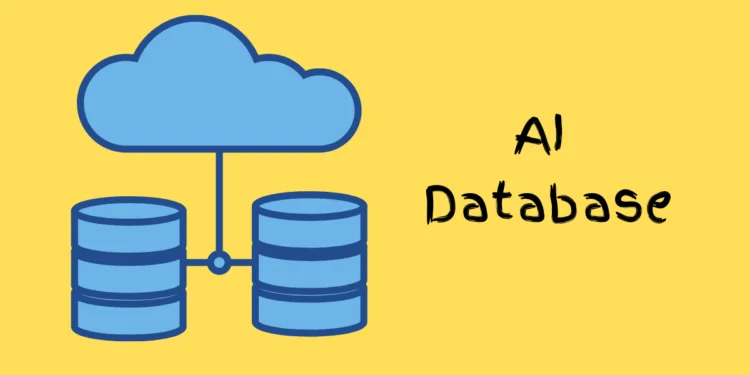Artificial intelligence allows a machine to perform or replicate human intellect. In order to perform this type of demand, databases are required. These databases are revolutionizing how data is being managed and utilized. Data and Business Intelligence are quite the same.
However, AI databases are specifically designed for training machine learning and deep learning models. These AI databases are responsible for handling large data volumes and processing power.
There have been heavy investments with the increase in AI and AI database developments, with the USA having 36.84% of the global AI share. This blog will give you more details regarding AI databases and how it works.
The history of AI databases goes back to the initial days of AI development. AI researchers used to depend on traditional databases for storing and controlling the data. However, with development in the field of AI, more advanced and specialized database management was required.
With the introduction of big-volume data in the early 2000s, the velocity and variety of data also increased and hence more and more advanced databases were created to tackle this scenario. In this present age, there are advanced AI databases like vector databases and cloud-based databases that can handle almost any type of demand.
Let’s look back at how AI has developed through the timeline since its introduction in the following image.
What is an AI Database?
An AI database is a type of database specifically constructed to cater to the peculiarities of artificial intelligence and machine learning algorithms. Some may compare it to a normal database which indicates that it will only work with structured data in tables format to a mass structured data efficiently. An AI database is designed to store, manage, and retrieve huge and different data types. The content here can be text, images, audio, or video, and it can be structured data or semi-structured data or even unstructured data.
Explainable AI: What It Is, How It Works, and Key Examples
Features of AI Database
Specific types of databases known as AI databases are the ones that are most suitable for intensive use with AI and machine learning applications. These databases provide features that are quite specific to make the management of data efficient, the performance of the databases better, and for fulfilling the requirements of the different activities of AI systems. Some of the important features of AI Databases are as follows:
Performance and Adaptability
AI databases are usually designed to face huge amounts of data and deliver efficient data retrieval and storage. The capability to increase the size of the database is also important, especially, when the amount of data will be growing year by year, and the performance of the system will not decrease.
Integration with ML Tools
These databases can easily work in parallel with multiple machine-learning frameworks and tools including TensorFlow, PyTorch, and Scikit-Learn. This integration is effective when it comes to training and deployment of the outcome from the machine learning models.
Real-Time Processing
It is very important for AI applications to work in a real-time scenario. They need to process the data in real-time. AI databases are used in real-time operations so that decisions are made on the real-time information available on any subject.
Support for Various Data Types
Most AI databases can handle all formats of data: structured, semi-structured, and unstructured data. This versatility is important because the data flows in AI applications vary as much as the specific algorithms and models.
Indexing and Querying
As fast data retrieval is appropriate in AI databases, the AI database needs to incorporate sophisticated indexing and querying methods. These approaches allow for fast and relevant searches and combining the obtained results for receiving the needed information.
Security and Compliance
Due to the nature of data used in AI applications, AI databases are characterized by a high level of security with the help of encryption, access control, and compliance with data protection legislation.
Definition of AI Database With an Example
An AI database is a type of data management system that is aimed to address the requirements of Artificial Intelligence and Machine Learning solutions. One of the best examples is Google BigQuery.
Google BigQuery
AI database examples include Google BigQuery. It is a serverless data warehouse that is also managed and which, following processing by Google, permits super-fast SQL queries. BigQuery has built-in machine learning capability making it possible to perform machine learning algorithms and querying on large inputs.
How BigQuery works :
The Primary stage is when the data is ingested from various sources as seen above. Then it is stored and processed. The final step is that it is being analyzed from the data it has been fed.
Also read: Who is the Father of Artificial Intelligence (AI)?
How does an AI Database work?
There are many steps and processes which are involved when an AI Database works. They are :
Feeding the Data
The primary step is transferring data from other systems into an AI database. This data originates from different sources such as social networks, transaction history, and others. The website employs connectors and APIs to obtain data either in real-time or in portions so that information within the database is up-to-date.
Storing the Data
Data enters the system, is processed, and is deposited into the AI database after ingestion. Depending on the type of the particular database the information may be arranged in the tables used in the relational database, as documents in the NoSQL database, or may be stored in the in-memory structures in case of in-memory database systems. A particular emphasis has been placed on the fact that the storage system has to allow for fast access to data so that when AI algorithms need to retrieve some data, they are able to do it without much delay.
Processing the Data
AI databases have the processing power to query and manipulate the data together with other functionalities. This entails pulling together data, screening out data that are extraneous to the problem, and also the process of converting data into forms that the models can easily understand. This activity can be carried out online, which means that results can be generated in real time should the need arise.
Indexing the Data
It should be noted that indexing is an indispensable component by means of which the speed and efficiency of data search are increased. Indexes in the AI databases are built following the given attributes of the data so that full and efficient searching is possible. This is especially relevant when working with big data where normal ways of searching data would be very time-consuming.
Integration of AI Algorithm
An AI database can connect easily with machine learning and AI structures. This integration enables data scientists to apply the results of their models right on the basic database without having to export any of the data. This close integration with the database also guarantees that the models that are to be trained, checked, and used can be done so with better ease.
Real-time analytics
Real-time analytics incorporated into AI databases deliver analyses based only on updated data to decision-makers in real-time. This is important in areas like fraud detection, recommendations, and preventive maintenance among others that need updated information.
Security and Privacy
AI databases ensure the effectiveness of various safety measures as far as sensitive information is concerned. This ranges from the issue of secure communications, limited access to the data, and adherence to the Data Protection Act. Looking at the protection of data then it is of great importance especially when it comes to the flow of data in various companies such as the health and financial sectors.
Let us group the above-mentioned steps into 3 main phases:

AI vs. Robotics: which is the better career option?
Limitations
There are certain limitations to the AI database as well. They are:
- Scalability Complexity: Most approaches that deal with large volumes of data can be very intricate to implement.
- Integration Issues: Combining multiple sources of data as well as structuring data in a way that can be consumed can at times be cumbersome because it requires building various data flows.
- Security Concerns: Ensuring that the information used by an AI system or generated by it is protected from external onslaught requires strict security measures.
- Performance Optimization: To sustain high performance for complex queries and real-time analysis, optimization and resource investments are required continuously. All these issues must be well handled to ensure that the AI databases are optimized in such applications.
Conclusion
AI databases are fundamental to present and future AI and machine learning techniques as they offer the platform needed for the ingestion of big data. They have high performance, scalability, near real-time processing, and security that are critical in attaining optimal use of AI. It is significant to learn more about AI databases and their basic characteristics to ensure proper implementation of AI in different fields.
AI Tokens Explained: What They Are and How to Calculate Them

















